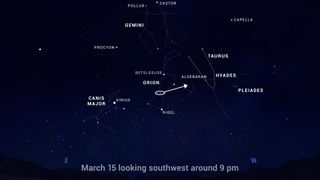Spot the Hyades star cluster near Taurus constellation tonight. Here's where to look.
Look up tonight (March 15) to see the Hyades star cluster light up the Taurus constellation in the night sky.

Look up tonight (March 15) to see the Hyades star cluster light up the Taurus constellation in the night sky.
The Hyades star cluster is the closest star cluster to Earth, located only 150 light-years away. Viewers can spot the star cluster by looking for the tall, Y-shaped constellation Taurus, the bull, which is situated high in the southwest sky on March evenings. The Hyades star cluster lies near the center of the constellation, forming the bull's face, according to NASA's March viewing guide.
Another trick to spot the Hyades star cluster is to use the stars of Orion's belt as a guide to locate the bright orange star Aldebaran. While Aldebaran isn't actually part of the star cluster, it is located halfway to Hyades and conveniently visible in the foreground, as a part of the V-shaped grouping of stars that comprises the bull's head.
Related: March night sky wonders: Strange sights to see every year
The Hyades grouping, containing hundreds of stars, is classified as an open star cluster because it's stars are close together in space, yet loosely bound together by their mutual gravity. While the stars formed together around the same time and from the same cloud of dust and gas, the leftover nebula material was blown away and the stars drifted apart, giving them an open, or diffuse, structure.
"Our own sun formed in a cluster like this," according to the NASA statement. "Studying these structures helps us understand how stars form and evolve."
The Pleiades star cluster, also known as the Seven Sisters, is another well-known open cluster located in the constellation Taurus. While the Hyades and the Pleiades star clusters are about the same size, measuring roughly 15 light-years across, the Pleiades cluster is about 3 times farther away. As a result, the Pleiades cluster appears more compact.
Get the Space.com Newsletter
Breaking space news, the latest updates on rocket launches, skywatching events and more!
The Hyades star cluster is visible to the naked eye tonight in the first few hours after dark and should be easy to spot in the night sky, given its compact and distinctive shape. While skywatchers will be able to see a handful of stars with the unaided eye, viewers looking to see more stars — up to a hundred or more — will need to use binoculars.
Our helpful guide for the best telescopes and best binoculars can help you find the right instrument. And, if you're hoping to snap photos of the star cluster, here are our guides for the best cameras for astrophotography and best lenses for astrophotography.
Editor's note: If you have an amazing night sky photo or video of the Hyades star cluster that you'd like to share for a possible story or image gallery, let us know! You can send in images and comments to spacephotos@space.com.
Follow Samantha Mathewson @Sam_Ashley13. Follow us on Twitter @Spacedotcom and on Facebook.
Join our Space Forums to keep talking space on the latest missions, night sky and more! And if you have a news tip, correction or comment, let us know at: community@space.com.

Samantha Mathewson joined Space.com as an intern in the summer of 2016. She received a B.A. in Journalism and Environmental Science at the University of New Haven, in Connecticut. Previously, her work has been published in Nature World News. When not writing or reading about science, Samantha enjoys traveling to new places and taking photos! You can follow her on Twitter @Sam_Ashley13.
